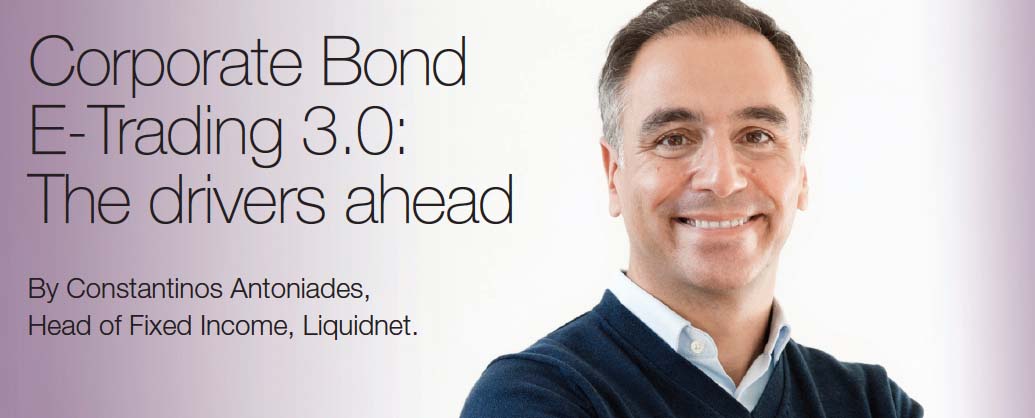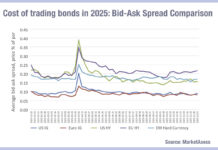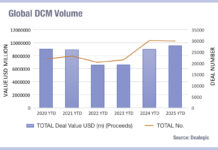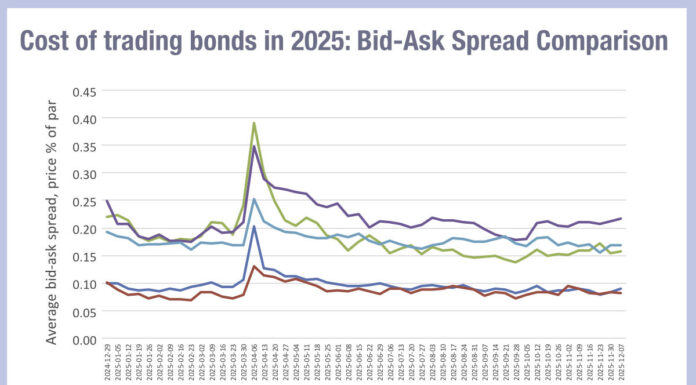As electronic trading in the corporate bond market increases, those platforms and market participants who intend to be at the cutting edge of the industry are already looking to define what the next iteration of electronic trading will be and how it may advance the future of the industry.
E-trading in corporate bonds started to make an impact around 10 years ago with the adoption of the request-for-quote protocol. More recently, e-trading version 2.0 arrived in the forms of all-to-all and dark pool trading. So, what will iteration 3.0 look like? What new innovations and additional benefits can the asset management community expect, and what will it mean for the market structure and trading landscape?
The vast majority of asset managers and dealers now use e-trading as part of their everyday workflow. In a report by Greenwich Associates, 83% of US-based credit investors indicated they already use electronic trading*. Equally important, e-trading has grown beyond its earlier role as an efficiency tool for smaller orders and more towards a liquidity discovery and execution avenue for institutional sized orders. The above makes for fertile ground for innovation, workflow improvements, and value delivery in the road ahead.
We believe the future will resemble a workflow that incorporates more automation and uses more data to navigate decision-making, that helps the buy side and sell side capture more liquidity with less effort. So how might these changes ultimately affect market participants? At Liquidnet, we see there being three main drivers:
More intelligent trading platforms
This does not entail complex, equity-style black box algorithms, but rather a simple and customisable set of rules that can make real-time suggestions for the optimal path to execution. The rules recognise that different orders probably have different best paths for execution based on bond characteristics, order characteristics, market activity and individual preferences. The goal will not be to “chop-up” the order, but rather better manage and execute an institutional-size order.
Specifically in Europe, intelligent execution at the trading platform level can also complement the best execution framework required by MiFID II, as well as provide a detailed audit trail to support a best execution policy.
Data aggregation and data management
Corporate bond market data today is fragmented amongst various dealer and broker desks, trading platforms, and third-party vendors. Also, the quality of data is inconsistent; some “axes” work, some are speculative, some are stale. While data availability today is much greater than even two to three years ago, data management and aggregation have not yet played a big role in delivering alpha to asset managers in a more systematic manner.
In conversations with Liquidnet Members, the desire to aggregate and use more data features highly on their list of priorities, whether via a custom system or using their OMS. Algomi’s recent acquisition of ALFA (developed by Alliance Bernstein) highlights the trend towards greater data aggregation and use. The goal of data aggregation is to help the trader identify more liquidity opportunities, or the highest probability outcome destination for a given order, by delivering an easily consumable snapshot of the relevant data together with a quality assessment based on historical data or the counterparty/venue. A more sophisticated version of data aggregation tools may even automate the sending of orders to the “most suitable” venue for a given order. Some of these functions may exist currently at the OMS or EMS level, but data aggregation will likely turbocharge such functionality, as well as reduce the amount of time traders spend trying to uncover natural liquidity.
The technology to aggregate, analyse, and present data can easily be made available, yet in most cases, it is a cost and resource issue. It is only a matter of time before the potential benefits of buying or building a sophisticated data aggregation tool will compare favourably to the cost. Some market participants have already invested in such tools. Going forward, it could become a source of tangible alpha generation and a must-have for success in a highly competitive industry.
Improved interconnectivity
For obvious commercial reasons, trading platforms have historically ring-fenced their order flow inside their ecosystem. While this was appropriate and natural for iterations 1.0 and 2.0 of the e-trading landscape, it is unlikely to provide the backbone for future success.
Most importantly, interconnectivity between trading platforms will not be a zero-sum game for the platforms involved. Chances are that no one trading platform has the best opposite liquidity for all orders at all times. Offering the ability to route an unexecuted order to another platform, or seek liquidity in multiple platforms should be viewed as progress, providing good customer service and likely to bring commercial advantages. Order routing has been desired by the buy side for some time now and asset managers are more likely to favour the visionary platforms of the future that offer these capabilities. By combining their respective strengths, interconnected platforms can deliver a better ecosystem to the marketplace.
The potential combination of intelligent execution, data aggregation, and trading platform interconnectivity presents a significant opportunity to elevate the value derived from e-trading to the next level. The main benefit for the buy side will be opportunities for alpha generation that are multiples of the magnitude delivered by e-trading today. Technology-wise, these advancements could take place now. The biggest obstacles are likely behaviour and resource prioritisation, both of which can be overcome with a clear analysis of the potential benefits, as well as demand from the buy side. Those trading platforms that have already invested heavily in technology, connectivity, data aggregation and data management are well positioned to pursue the initiatives that will drive e-trading 3.0 and deliver solutions with considerable benefits.
As the evolution continues – for the buy side, sell side, and trading platform vendors alike, it will only create a wider gap on the leaderboard between those who excel and lead, versus those who fall further behind. These differences will ultimately manifest themselves in the ability to generate alpha and performance. Asset managers who combine the mentality, process, willingness, and resources to adopt smarter technology will be presented with additional liquidity and alpha generation opportunities, compared to those who do not embrace the benefits offered by the powerful combination of changing market structure and technology.
*Greenwich Associates: Corporate Bond Electronic Trading Continues Growth Trend, July 2016
©Markets Media Europe 2025













